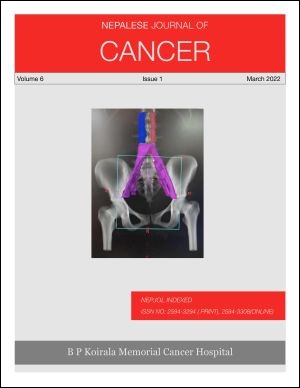Importance of Aortic Bifurcation for Pelvic Radiotherapy in Cervical Cancer Patients
DOI:
https://doi.org/10.3126/njc.v6i1.44206Keywords:
aortic bifurcation, carcinoma cervix, pelvic radiotherapyAbstract
Purpose: Radiotherapy is a major modality for treating cervical cancer patients. Conventionally, superior border of treatment portal in cervical cancer is kept at L4-L5 intervertebral spaces; however, newer concepts suggest that aortic bifurcation should be the determining factor for the superior border. This study aims to observe the level of aortic bifurcation in cervical cancer patients.
Methods and materials: A retrospective observational study was conducted in cervical cancer patients undergoing radiotherapy between July 2019 and August 2020 in B.P. Koirala Memorial Cancer Hospital, Bharatpur. Histologically confirmed International Federation of Gynecology and Obstetrics (FIGO) stages II and III carcinoma cervix patients referred for radiation therapy were included in the study. Baseline variables including age group, FIGO stages were noted from the hospital record. Computed Tomography (CT) simulation images were reviewed from the treatment planning system to detect the levels of aortic bifurcations.
Results: Total 281 patients of carcinoma cervix were registered for the study with age ranging from 29 years to 87 years and the commonest age group being 51-60. The maximum patients were of stage IIB (46.6%). The aortic bifurcations levels varied from mid L3 to L5-S1 intervertebral space and the commonest level observed was mid L4 vertebra in 70 (24.9%) patients.
Conclusion: Anatomical variation in the level of aortic bifurcation, considered as the superior CTV border in pelvic radiotherapy in cervical cancer, demands the conventional superior border, L4-L5 intervertebral space, to be shifted more superior to include common iliac nodes in the treatment field.
Downloads
Downloads
Published
How to Cite
Issue
Section
License
Copyright (c) 2022 Nepalese Journal of Cancer

This work is licensed under a Creative Commons Attribution 4.0 International License.
This license lets others distribute, remix, tweak, and build upon your work, even commercially, as long as NJC and the authors are acknowledged.
Submission of the manuscript means that the authors agree to assign exclusive copyright to NJC. The aim of NJC is to increase the visibility and ease of use of open access scientific and scholarly articles thereby promoting their increased usage and impact.




